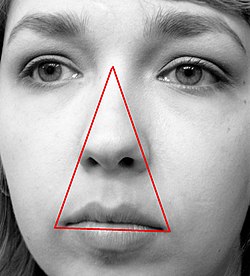Danger triangle of the face
| Danger triangle of the face | |
|---|---|

|
|
|
Anatomical terminology
[]
|
The danger triangle of the face consists of the area from the corners of the mouth to the bridge of the nose, including the nose and maxilla. Due to the special nature of the blood supply to the human nose and surrounding area, it is possible, albeit extremely unlikely, for retrograde infections from the nasal area to spread to the brain, causing cavernous sinus thrombosis, meningitis or brain abscess.
This is possible because of venous communication (via the ophthalmic veins) between the facial vein and the cavernous sinus. The cavernous sinus lies within the cranial cavity, between layers of the meninges and is a major conduit of venous drainage from the brain. Despite this relatively plausible anatomical argument, only severe facial infections (e.g., nasal abscess) can lead to a deeper central nervous system infectious complication.
It was discovered that venous valves are present in the ophthalmic and facial veins. Thus, it is not the absence of venous valves but rather the existence of communications between the facial vein and cavernous sinus and the direction of blood flow that is important in the spread of infection from the face. Most people, but not all, have valves in these particular veins of the face.
The relationship between this area and a risk of cavernous sinus thrombosis was described as early as 1852. In 1937 a study found that 61% of the cases of cavernous sinus thrombosis were the result of furuncles on the upper part of the face. While the disorder has become extremely uncommon with the development of antibiotics, it still carries a very small chance to develop a high risk of death and needs to be treated aggressively with antibiotics and blood thinners.
...
Wikipedia
